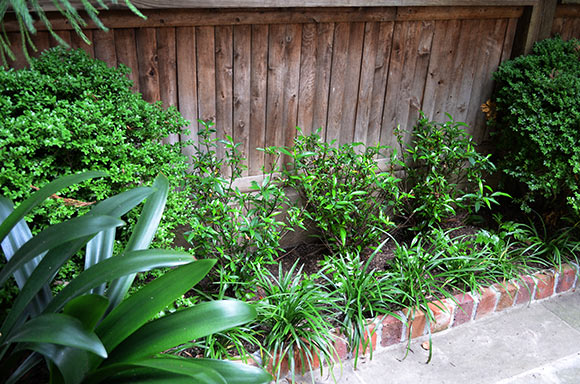
If you remember (and many of you shared my pain), last Winter’s brutal cold spells and freezes did a number on many of my broad-leafed evergreens. Gardenias, cast iron plants, Daphne odora, tender azaleas, loropetalum, yaupon hollies, ligustrum, waxmyrtle, some nandinas, some Southern magnolias, figs, cleyera, windmill palms, fatsia, camellias, chindo viburnums, mondo and dwarf mondo grass, and macrophyllahydrangeas (the blue/pink ones), were all damaged, some severely. In the end, I lost three windmill palms, and maybe the fourth (still patiently waiting on that one—it’s the biggest of the four); one gardenia; and two camellias (one Fall-bloomer and one Spring-bloomer). My usually spectacular camellias, which were heavily budded, had barely a flower—the buds were frozen—but the plants recovered nicely and are now setting buds for next Spring’s blooms. I have many, many hydrangeas, and they are all recovering, yet the only ones to bloom were the H. arborescens varieties, like ‘Annabelle’. These hydrangeas bloom off the new growth, so their blooms are pretty much a sure thing every year.
Honestly, my gardenias have had the most amazing recovery. They truly looked dead as doornails and then, in early July, started to show the faintest bit of life. Now, they are recovering beautifully. Even two of the three very Southern gardenias—rooted by Miss Tina, in Wilmington, NC, and given to me; we call them Gardenia ‘Valentina’—are coming back from the root, strongly. They had sailed through the previous three Winters and gotten about three feet tall. Their flowers were huge and spectacular. And the scent!!!
My fingers are crossed that we don’t have another brutal Winter…I’m not sure how these tenderly recovering plants will be able to stand up to another cold one. We will see. I’m just thrilled to see these plants spring back to life as they did. And my yard is as lush as it’s ever been. I’m ever astounded at the resilience of plants—provided I give them the time they need to recover.
Next Story: It’s Been a Great Year For Crapemyrtles >
